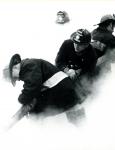Philosophy
BUT IS IT ART?
I do not use the word “Truth” when I talk about photojournalism. I also do not use the word “art.”
We are not in the business of providing Truth to our readers and viewers; that is the business of preachers. Journalists are in the business of providing Accurate, Fair and (hopefully) Complete information to our readers and viewers so they can make informed choices for our society. A free society demands access to accurate information. It is the only way our system of government can survive.
Photojournalism is not an Art. Photojournalism is a craft. The word “art” has as much place in journalism as “truth.” I am not opposed to “truth” or “art” but these aspects of life are not part of the core of Journalism.
I am interviewed by dozens of students every year (usually near the end of semesters when term papers are due) and recently I had a discussion with a student who was wondering what my views were on the idea that “changing the content of a documentary photograph was acceptable because photojournalism is an art form and therefore open to whims of the artist.” As you might guess, I choked on this concept. (The student got this idea from the professor teaching the class, God help us all.)
I spent thirty-five years as a photojournalist and photo editor at The Hartford Courant and I always considered myself a Journeyman Craftsman. I never considered myself to be a master craftsman and I absolutely never considered myself to be an artist.
On Sundays in church I know the “Truth” and in my free time, I have been known to create photographic art. For forty hours a week I was a craftsman attempting to pass along accurate information to my readers as fairly and completely as I could. I am very proud to have been a journeyman craftsman. It was an honorable profession.
There is artistic structure in the best photojournalism. We know the Rule of Thirds; we know the difference between warm and cold colors; we know the eye goes to the lightest part of the picture so we dodge and burn to bring out the content of the photo. Writers know how to use punctuation etc. but there is a difference between prose and poetry. Even the best word journalists do not write in rhymed couplets.
And there is no place in print journalism for poetic license. And there is no place in photojournalism for the changing of the content of a documentary photograph to make it say what you think it should say or to make it prettier or to conform with your preconceived notions.
We all have values and these values motivate our work and give direction to our photojournalism, especially when we are working on a project. We spend hours in homeless shelters photographing the people there because we believe our photographs can make a difference. We believe in the dignity of all people and that even the most dissipated individuals deserve our help if they want to reclaim their lives. These values, these ‘Truths” drive our photojournalism but they can never override our belief in the ultimate journalistic values of Accuracy, Fairness and Completeness.
This is a very complex question and one that deserves an entire semester’s worth of discussion. Is the purpose of journalism to hold up a mirror to society so citizens can see what is happening or to hold up a lamp, to lead society toward a better world? Basic, basic questions.

